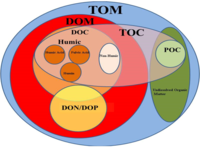
Photo from wikipedia
Crops assemble and rely on rhizosphere-associated microbiomes for plant nutrition, which is crucial to their productivity. Historically, excessive nitrogen fertilization did not result in continuously increasing yields but rather caused… Click to show full abstract
Crops assemble and rely on rhizosphere-associated microbiomes for plant nutrition, which is crucial to their productivity. Historically, excessive nitrogen fertilization did not result in continuously increasing yields but rather caused environmental issues. A comprehensive understanding should be developed regarding the ways in which crops shape rhizosphere-associated microbiomes under conditions of increased nitrogen fertilization. In this study, we applied 16S and 18S ribosomal RNA gene profiling to characterize bacterial and fungal communities in bulk and rhizosphere soil of rice subjected to three levels of nitrogen fertilization for 5 years. Soil biochemical properties were characterized, and carbon-, nitrogen-, and phosphorus-related soil enzyme activities were investigated, by assays. Increasing nitrogen fertilization led to a decreasing trend in the variation of microbial community structures and demonstrated a more definite influence on fungal rather than bacterial community compositions and functions. Changes in the level of nitrogen fertilization significantly affected chemical properties such as soil pH, nutrient content, and microbial biomass levels in both rhizosphere and bulk soil. Soil enzyme activity levels varied substantially across nitrogen fertilization intensities and correlated more with the fungal than with the bacterial community. Our results indicated that increased nitrogen input drives alterations in the structures and functions of microbial communities, properties of soil carbon, nitrogen, and phosphorus, as well as enzyme activities. These results provide novel insights into the associations among increased nitrogen input, changes in biochemical properties, and shifts in microbial communities in the rhizosphere of agriculturally intensive ecosystems.
Journal Title: Frontiers in Microbiology
Year Published: 2021
Link to full text (if available)
Share on Social Media: Sign Up to like & get
recommendations!